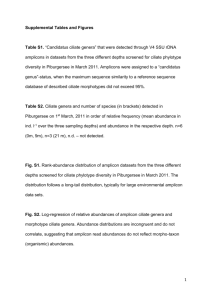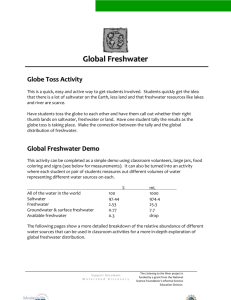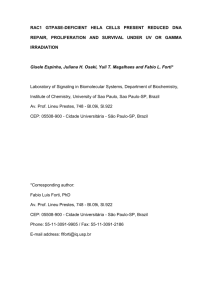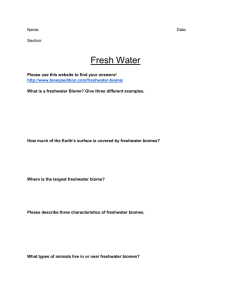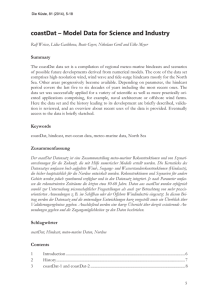FWF project application
advertisement
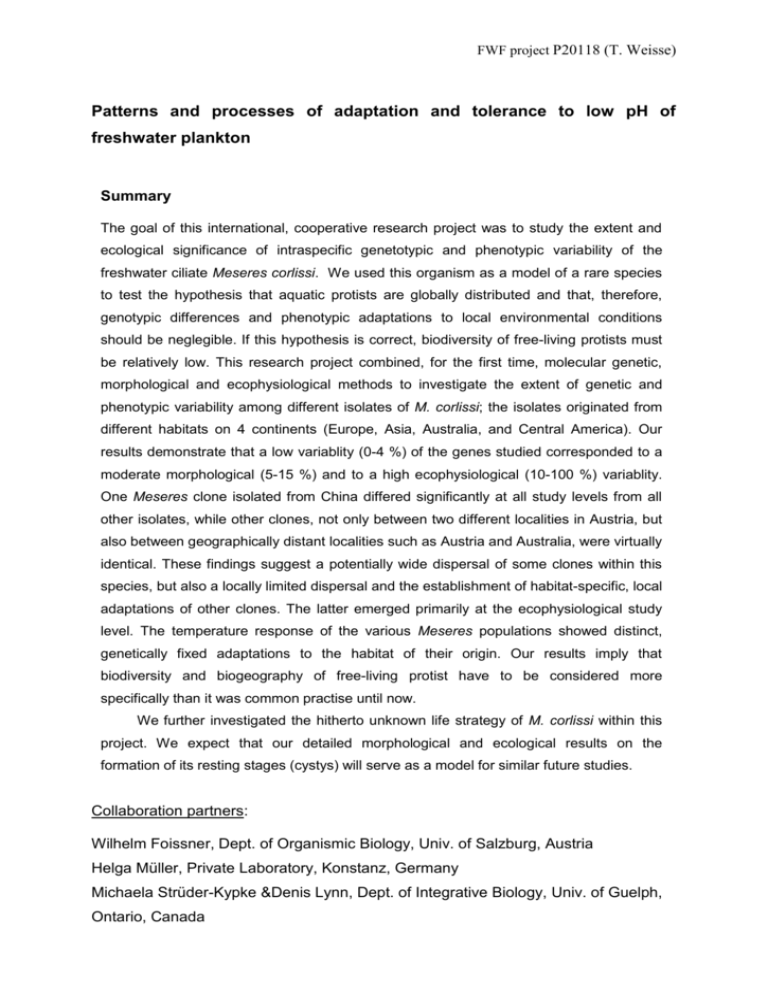
FWF project P20118 (T. Weisse) Patterns and processes of adaptation and tolerance to low pH of freshwater plankton Summary The goal of this international, cooperative research project was to study the extent and ecological significance of intraspecific genetotypic and phenotypic variability of the freshwater ciliate Meseres corlissi. We used this organism as a model of a rare species to test the hypothesis that aquatic protists are globally distributed and that, therefore, genotypic differences and phenotypic adaptations to local environmental conditions should be neglegible. If this hypothesis is correct, biodiversity of free-living protists must be relatively low. This research project combined, for the first time, molecular genetic, morphological and ecophysiological methods to investigate the extent of genetic and phenotypic variability among different isolates of M. corlissi; the isolates originated from different habitats on 4 continents (Europe, Asia, Australia, and Central America). Our results demonstrate that a low variablity (0-4 %) of the genes studied corresponded to a moderate morphological (5-15 %) and to a high ecophysiological (10-100 %) variablity. One Meseres clone isolated from China differed significantly at all study levels from all other isolates, while other clones, not only between two different localities in Austria, but also between geographically distant localities such as Austria and Australia, were virtually identical. These findings suggest a potentially wide dispersal of some clones within this species, but also a locally limited dispersal and the establishment of habitat-specific, local adaptations of other clones. The latter emerged primarily at the ecophysiological study level. The temperature response of the various Meseres populations showed distinct, genetically fixed adaptations to the habitat of their origin. Our results imply that biodiversity and biogeography of free-living protist have to be considered more specifically than it was common practise until now. We further investigated the hitherto unknown life strategy of M. corlissi within this project. We expect that our detailed morphological and ecological results on the formation of its resting stages (cystys) will serve as a model for similar future studies. Collaboration partners: Wilhelm Foissner, Dept. of Organismic Biology, Univ. of Salzburg, Austria Helga Müller, Private Laboratory, Konstanz, Germany Michaela Strüder-Kypke &Denis Lynn, Dept. of Integrative Biology, Univ. of Guelph, Ontario, Canada FWF project P20118 (T. Weisse) Publications related to this project: 1. Weisse, T. (2004). Meseres corlissi: a rare oligotrich ciliate adapted to warm water and temporary habitats. Aquat. Microb. Ecol. 37: 75-83. PDF 2. Foissner, W., Müller, H. & Weisse, T. (2005). The unusual, Lepidosomecoated resting cyst of Meseres corlissi (Ciliophora: Oligotrichea): Light and scanning electron microscopy, cytochemistry. Acta Protozool. 44: 201-215. 3. Foissner, W., (2005). The unusual, Lepidosome-coated resting cyst of Meseres corlissi (Ciliophora: Oligotrichea): Transmission electron microscopyand phylogeny. Acta Protozool. 44: 217-230. 4. Müller, H., Foissner, W. & Weisse, T. (2006) The role of soil in the life cycle of Meseres corlissi (Ciliophora: Oligotrichea): experiments with two clonal strains from the type locality, an astatic meadow pond. Aquat. Microb. Ecol. 42: 199208. PDF 5. Foissner, W., Pichler, M., Al-Rahsheid, K. & Weisse, T. (2006) The unusual, Lepidosome-coated resting cyst of Meseres corlissi (Ciliophora: Oligotrichea): encystment and genesis and release of the lepidosomes. Acta Protozool. 45: 323-338. 6. Foissner, W. & Pichler, M. (2006) The unusual, Lepidosome-coated resting cyst of Meseres corlissi (Ciliophora: Oligotrichea): Genesis of four complex types of wall precursors and assemblage of the cyst wall. Acta Protozool. 45: 339-366 7. Gächter E. and Weisse T. (2006) Local adaptation among geographically distant clones of the cosmopolitan freshwater ciliate Meseres corlissi. I. Temperature response. Aquat.Microb. Ecol. 45: 291-300. PDF 8. Weisse, T., Scheffel, U., Stadler , P. & Foissner, W. (2007). Local adaptation among geographically distant clones of the cosmopolitan freshwater ciliate Meseres corlissi. II. Response to pH. Aquat. Microb. Ecol. 47: 289-297 PDF 9. Müller, H. (2007) Live observation of excystment in the spirotrich ciliate Meseres corlissi. Europ. J. Protistol. 43: 95-100 10. Müller, H., Achilles-Day, U.E.M. &Day, J.G. (2008) Cryopreservation of resting cysts of the freshwater ciliate Meseres corlissi by conventional two-step methods and one-step vitrification ProtocolS. CryoLetters 29: 329-338. FWF project P20118 (T. Weisse) 11. Gächter, E. and Weisse, T. (2008): Long-term acclimation of growth rates in the oligotrich freshwater ciliate Meseres corlissi. Verh. Internat. Verein. Limnol. 30: 218-222. 12. Weisse, T., Strüder-Kypke, M., Berger, H. & Foissner, W. (2008): Genetic, morphological, and ecological diversity of spatially separated clones of Meseres corlissi Petz and Foissner, 1992 (Ciliophora, Spirotrichea). J. Eukaryot. Microbiol. 55: 257-270.



